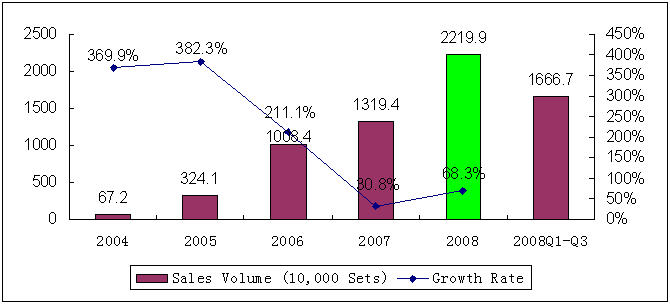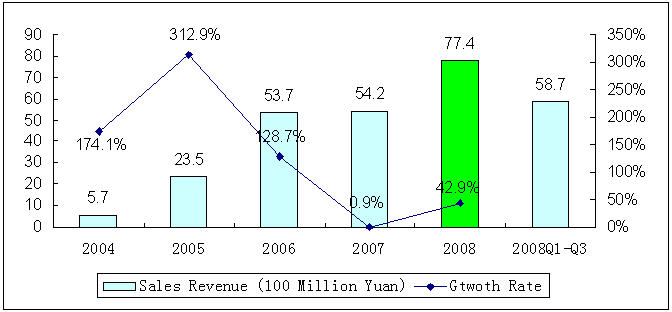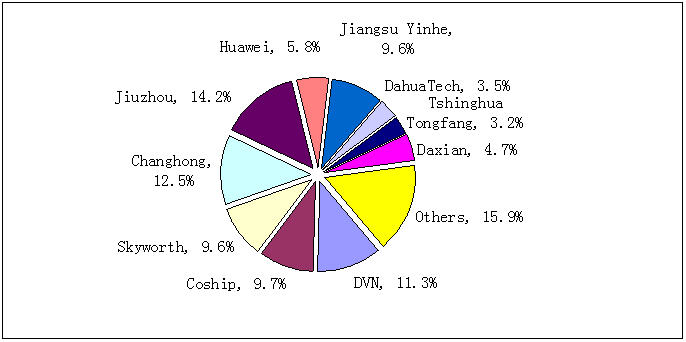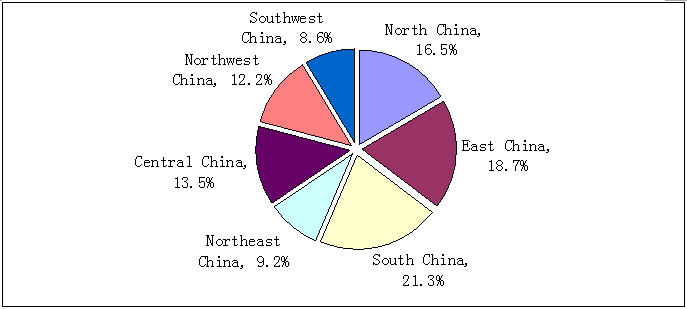China's STB Market to Maintain Steady Growth
Monday, November 24th, 2008BEIJING — CCID Consulting, China’s leading research, consulting and IT outsourcing service provider, and the first Chinese consulting firm listed in Hong Kong (Hong Kong Stock Exchange: HK08235), recently released a report on the prospect of China’s STB market.
In 2008, the strong performance of China’s digital TV industry, especially cable digital TV, also drove the development of China’s digital TV STB market. CCID Consulting statistics show that sales volume in 2008 Q1 to Q3 reached 16.667 millions, up 83.4% over the same period in 2007.
Explosion of China’s STB market lies in following factors. Firstly, National Broadcasting and TV Bureau have accumulated considerable successful experiences after several years of cable TV operation, which speeds up the migration to digital TV. Secondly, China’s has a huge STB manufacturing base. There are more than 200 STB manufacturers in China, among which production capacities of Jiuzhou, Changhong, Coship, and other STB companies reach millions. China’s STB market is getting more competitive and price of STB are decreasing. STB purchasing pressure of cable TV operators is reduced. Thirdly, with more digital TV related enterprises involve in digital TV conversion and achieve business mode innovation, the migration from analog TV to digital TV has been accelerated.
In 2008, most cities enhanced their migration process to digital TV before the Olympic Games to ensure more users could watch Olympic Games with digital TV. The CCBN Exhibition in March brought a large stack of orders to STB companies. The sales revenue of the STB market reached 5.87 billions in the first three quarters of 2008, up 53.1% over the same period in 2007. The increasing sales volume of high definition, bi-direction, and other high-end STB products slowed the downslide trend in price of STB products, which in turn drove up the sales revenue.
Figure 1: Sales Volume of China’s Digital TV STB Market in 2004-2008

Source: CCID Consulting, Oct. 2008
Figure 2: Sales Revenue of China’s Digital TV STB Market in 2004-2008

Source: CCID Consulting, Oct. 2008
In 2008, competition within the STB market heated up, with the competition mode switching from product, technology, and service to industrial cooperation. STB manufacturers are also having more business cooperations with digital TV operators. STB manufacturers and digital TV operators undertake risk and share profits commonly.
Jiuzhou assumed a leading position in STB market in 2008, performing strong in both domestic and abroad market. Changhong ranked 2nd with a market share of 12.5%. The sales volume of Digital Video Networks also increased with a market share of 11.3% and 9.7%, respectively. Brands outside of the top 10 brands achieved good performance as well. Compared with 2007, market concentration ratio of top 10 brands decreased because production scale of mainstream companies cannot meet with the demand of the new market.
Figure 3: Brand Structure of China’s Digital TV STB Market in 2008 Q1-Q3

Source: CCID Consulting, Oct. 2008
In 2008, digital terrestrial television systems were set up in Beijing, Shanghai, Shenzhen, Tianjian, and other cities, with trials in Qinhuangdao, Qingdao, Shenyang, Guangzhou, and other cities. STBs of DTT were yet to available for television viewers. Toshiba and other brands release terrestrial television integrative sets in Beijing, while Qingdao and other Olympic cities integrated STB functions into TV sets. Emerging integrative TV sets is expected to impact STB sales. STB of satellite digital TV has few improvements due to policies and absence of operators. With China Telecom strengthening the development of IPTV, an order of 574 thousands STB sets are in place.
Table 1: Product Structure of China’s Digital TV STB Market in 2004-2008
Unit: 10K Sets 2004 2005 2006 2007 2008 Q1-Q3
Cable 61.1 295.1 953.2 1219.3 1574.6
Terrestrial 1.1 3.8 18.4 26.4 23.7
Satellite 2.2 3.1 8.5 10.0 10.1
IP 2.8 22.1 28.3 63.7 58.3
Total 67.2 324.1 1008.4 1319.4 1666.7
Source: CCID Consulting, Oct. 2008
In 2008, North China, East China, and South China are main regions in China’s STB market according to the development plan of the National Broadcasting and TV Bureau based on economy development and population. In 2008 Q1-Q3, digital TV subscribers in Guangdong, Jiangsu, Guangxi, Zhejiang, and other provinces increased rapidly, which resulted in the largest STB sales volume in South China and East China.
Figure 4: Regional Structure of China’s Digital TV STB in 2008 Q1-Q3

Source: CCID Consulting, Oct. 2008
CCID Consulting forecasts that continuous development of cable digital TV will bring more market opportunities.
In 2008, the National Broadcasting and TV Bureau’s original plan was to finish terrestrial digital TV network construction in 37 cities and begin providing SDTV and HDTV services, which was expected to bring tens of million potential subscribers. However, there are several problems to be solved. Firstly, the current terrestrial digital TV system only provides one HDTV channel and six SDTV channels, which fails attract enough users. Secondly, integrative sets are too expensive to be accepted by most people, and the price of STB will still stay in high level due to expensive chips. Finally, TV stick and other substitute products will attract part of terrestrial TV users. Several companies release TV stick products, among which are less than 200 Yuan.
Policies and TV operators of satellite digital TV will not be determined in a short time. As a result, users of satellite digital TV are still restricted in ‘Communication with Every Village’ and other political projects. CCID Consulting forecasts that the sales volume of satellite TV STB is unlikely to achieve rapid growth in the meantime.
Telecom reorganization will slow down the development of IPTV in the short-term. However, China Telecom and China Netcom invested heavily on IPTV in the first half of 2008. Existing policies and actions will drive development of IPTV in long-term.
In a word, CCID Consulting forecasts that the sales volume of China’s STB market will reach 22.199 millions, keeping a strong momentum of rapid growth.
Latest News
- Tata Motors selects HARMAN Automotive's in-vehicle app store
- Media Distillery to power Swisscom ad-free replay product
- MagentaTV strengthens addressable TV business with Equativ
- Deutsche Telekom selects Broadpeak Cloud DVR solution for MagentaTV
- Nexxen empowers Australian advertisers using VIDAA ACR data
- TargetVideo integrates AI for video content categorization